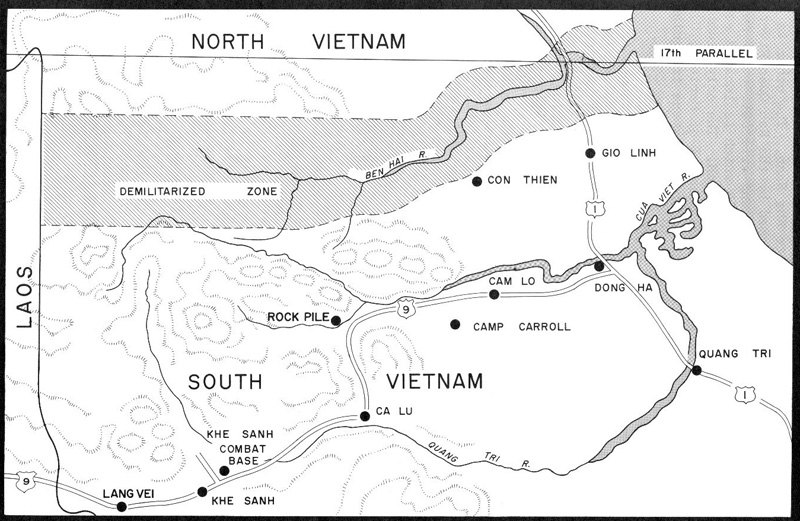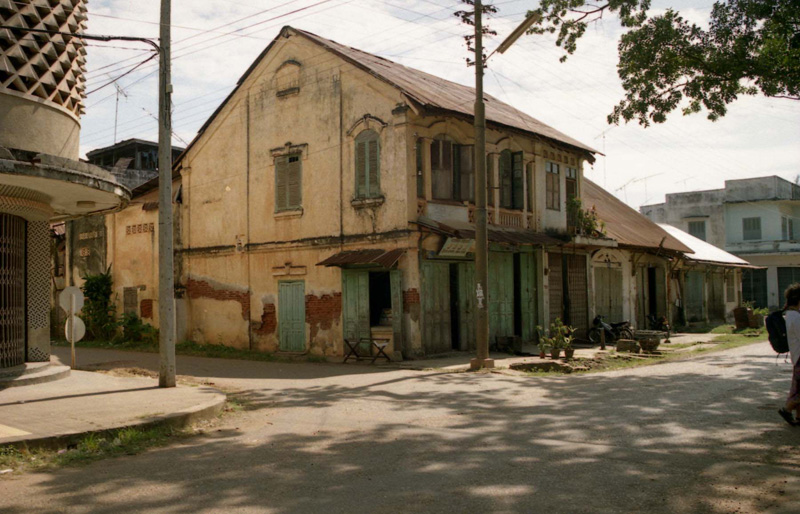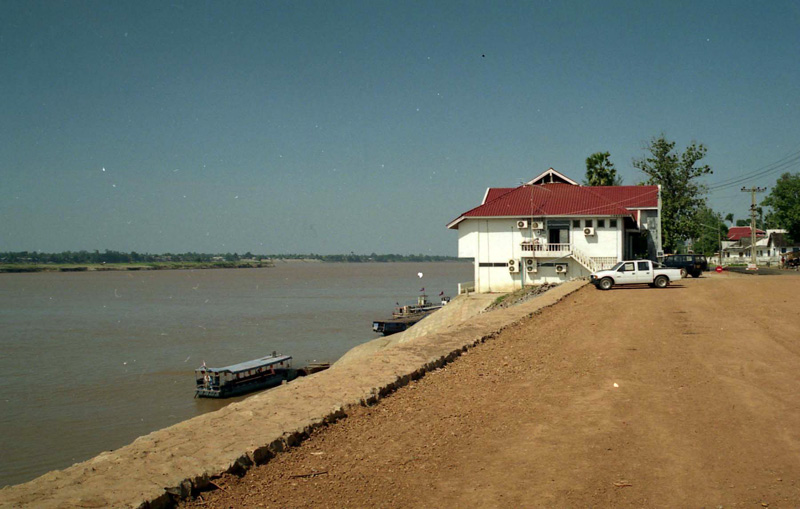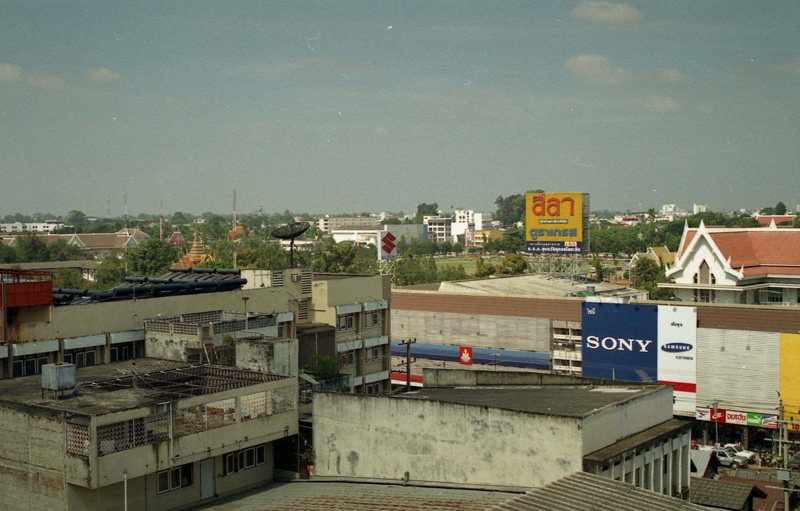The Road To Lao Bao
In November 1996, I had spent two weeks travelling by train from Ho Chi Minh City (Saigon) to Hue the old Emperorial Capital of Vietnam and I had decided it was time to leave Vietnam for sunnier pastures. It had been raining non-stop since I arrived in Hue, the Perfume River had broken its banks and half of Hue was under at least a foot of water. My hiking boots where soaked thru and I was starting to develop trench foot!

Since 1994 the Vietnamese/Laotian Border had been open to foreigners at Lao Bao, enabling foreigners to travel overland across southern Laos to Thailand. I had obtained a 7 day Laotian Transit Visa in Ho Chi Minh City for USD$50 and when I applied for my Vietnamese Visa in Australia, I had put down the Lao Bao border crossing as the exit point on my visa application. I was all set to continue my journey and to travel on to Laos, then Thailand.
Eighty kilometres north of Hue, from 1954 to 1975, was the D.M.Z. – the De Militarised Zone, which used to separate South Vietnam and North Vietnam. All along the D.M.Z., are the old American and Vietnamese Fire Bases, including the most famous one of them all; – Khe Sahn. Now twenty one years later after the Vietnam War had finished, tour companies in Hue where offering full day tours of the D.M.Z. and for a miserly USD$12, they would drop you off in the village of Khe Sahn, about four km’s from the old fire base and twelve km’s from the Lao Bao border crossing. I was told for USD$1, the local Vietnamese would take you to the border crossing, on the back of their motorbikes.
After three nights in Hue, the next morning I boarded the tour bus which was going to take about twenty western tourists on a tour of the former DMZ and take me most of the way to the Laotian border. Twenty km’s north of Hue, the road was cut by floodwaters and the bus driver was forced to turn around, back to Hue. So much for Plan A!!
On the way back to Hue, I started thinking about Plan B. On arrival back in Hue, I decided to catch a train eighty km’s north to the town of Dong Ha, on the southern edge of the DMZ and then take a bus eighty km’s directly east to the Lao Bao border crossing. On my arrival back in Hue, I dropped my pack off at my old hotel and caught a cyclo to the railway station. At the railway station, I was told that there was only one train per day to Dong Ha and the next one was leaving Hue at 6:00am, the following morning. I purchased a ticket for 80,000 Vietnamese Dong and returned to my hotel.
The next morning, I was up at 4:00am and I left my hotel at 5:00am in a cyclo for the railway station. The train was already waiting at the railway station and just after 6:00am, the train pulled out of the railway station heading north towards Dong Ha. The carriage I was in, looked like it had been built by the French and had been in service for at least fifty years. The carriage was clean, but the seats where hard, with no padding. In front of me was 5-6 Vietnamese Students from Hue University going home for a holiday. The train was very slow, averaging about 30 kmh and as it was a local train, it stopped at every station, no matter how small it was. After an hour or so, the Vietnamese Students turned around and started talking to me. There were very interested in where I was from and what I had been doing in Vietnam. I told them, I was a Network Administrator and I worked at a University in Australia, which interested them. As I was talking to them, one by one they would slowly disappear as the train arrived at their destination, until there was a nineteen year old female student who lived in Dong Ha and me. She was very attractive and she asked me to come back to her home in Dong Ha. I don’t know whether her attentions where innocent, but I declined her offer as I was eager to get to Laos that day and I had been warned about being seen alone in public with Vietnamese Women, as some Vietnamese Men can be racist and automatically assume that a Vietnamese Woman with a westerner is a prostitute. When we got off the train in Dong Ha, she asked me again and she seemed a bit offended when I declined again, but there where already 4-5 Vietnamese Men around us, who where making lewd comments. After saying goodbye to her, I walked up to the main road – Highway One.
As I walked up the road towards the bus station, the usual entourage arrived, wanting to know what I was doing in Dong Ha. I explained, I was walking to the bus station to catch a bus to the Lao Bao Border Crossing. They told me that the next bus to Lao Bao wasn’t leaving for another 3-4 hours, but surprise, surprise they had a friend who could take me there on the back of his motor scooter. Within five minutes “the friend” had arrived, who turned out to be an ex-South Vietnamese Soldier who had been an interpreter for the U.S. Marines in the late 1960’s and had been stationed along the DMZ. He was currently working as a guide, taking western tourists on tours from Hue, to the DMZ. After haggling for five minutes and getting nowhere, I agreed to pay USD$15 for him to take me to the border crossing at Lao Bao, a distance of eighty km’s.

After pumping up the tyres on his motor scooter, we headed west to Lao Bao. I don’t think his motor scooter was designed to take an 85kg Australian Backpacker and his backpack, as the back of his motor scooter was sagging considerably! As we rode along, he pointed out the old firebases and other points of interest. After an hour we stopped at a roadside shack where we had something to eat and drink. As we travelled on towards Lao Bao, we stopped at a road intersection, where a road went south to the infamous A Shau Valley. The road and a bridge over the Quang Tri River to the A Shau Valley was built by Cuban’s in the late 1970’s and my Guide / Motor Scooter Driver told that this area was off limits to all westerners, as there were still a lot of Montagnards (Hill Tribes) living in this area and some still had loyalty to Americans and other westerners. After about two hours we arrived at the village of Khe Sahn, where my Motor Scooter Driver promptly informed me that he wanted my Australian Baseball Cap and he offered to buy me a replacement at the local market. I told him that it wasn’t necessary for him to buy me a replacement hat and he could have it for free. My Motor Scooter Driver still went off for ten minutes to do some shopping and probably to check in with the local authorities and explain who the westerner was. As I waited for my Motor Scooter Driver, I looked across towards Laos and I could see the hills just over the border in Laos from where the North Vietnamese Artillery used to shell the American Khe Sahn Firebase in 1968. The old American Khe Sahn Firebase is only 4km north of the village of Khe Sahn, but as I thought I was running out of time, we continued on to the Lao Bao border crossing, where we arrived in about twenty minutes. I paid my Guide / Motor Scooter Driver about USD$18 in Vietnamese Dong, as the Vietnamese Dong is worthless outside of Vietnam and I gave him my baseball cap. He still wasn’t very happy with this deal, but I didn’t really care. After two weeks in Vietnam, I was tired of some of the Vietnamese with their hand constantly out, expecting something for nothing because I was a “Rich Westerner” and they where living in a communist country. Ten years later, I had similar experiences when I went to Ukraine.
The village of Lao Bao isn’t very big and at the western end of Lao Bao there is a large modern Immigration & Customs Building capable of taking vehicle and pedestrian traffic. The Lao Bao Border Crossing had only opened to westerners in 1994 and westerners were still a bit of a novelty when I was there. As I approached the Immigration & Customs Building, two Vietnamese Girls stopped me, trying to get me to change some of my US Dollars into Laotian Kip and despite being unaware of correct exchange rate, I changed USD$10. I then walked up to the Service Window of the Immigration & Customs Building and presented my Australian Passport to the Vietnamese Immigration Officer. He didn’t seem very pleased to see me and despite having “AUSTRALIA” written in very large letters on the front of my passport, he couldn’t find Australian on his long list of Nationalities that are allowed to use this border crossing. After a few minutes, he tried to put “British” down as my nationality on his form, until I showed him on his list, the Vietnamese word for Australian – “Uc Dai Loi”. He then stamped me out of Vietnam and I walked up the road towards Laos.
Stopping briefly to look at a concrete border marker, I walked along the road, which then went up a hill to the Laotian Border Post. Following me was a western couple and the two Vietnamese Girls, which had changed my USD$10 Note into Laotian Kip. When we arrived at the Laotian Border Post & Immigration Building, we were promptly told that the Laotian Border Guards where having their “siesta” and we had to wait an hour until the Laotian Immigration Office opened. Whilst we waited the Vietnamese Girls continued to pester me to exchange more US Dollars for Laotian Kip. One of the Vietnamese Girls eventually gave me a big roll of Laotian Kip Notes to hold, which I promptly stuck in my back pocket and I then sat down, refusing to return the money. Everybody except the two Vietnamese Girls laughed. After about five minutes both of the Vietnamese Girls started to get very agitated, as they started to think I wouldn’t return their money. Eventually I gave their money back to them, but after two weeks in Vietnam, I had become sick of being pestered all of the time to buy something or constantly dealing with people who seemed to be dishonest. I started talking to an American Woman and her Scottish Boyfriend and they told me that it was a common practice for Vietnamese to rip westerners off, when exchanging money on the black market by handing over a wad of notes, with large denomination notes on the outside and very small denomination notes or newspaper on inside. After an hour of sitting around chatting, the Laotian Border Guards had finished their “siesta” and they stamped us all into Laos.
We left the Laotian Border Post and walked about a km along the road and over a bridge to a small Laotian Village, where we were told that we could get a truck that would take us to the other side of Laos, to Sawannakhet on the Mekong River.

We stopped in the middle of the village, next to a truck and three men who were loading it. The driver or the owner came up to greet us and the American Woman started haggling a price to take us to Sawannakhet. Eventually we agreed on paying about USD$10 and we were told that we had to wait about 45 minutes, before the truck would be ready to leave. The Laotian Border Guards and the Laotian people we had started to meet were very friendly and laid back compared to the Vietnamese. As we sat on our backpacks on the edge of road, the strangest thing that has ever happened to me whilst travelling occurred. It was starting to become obvious that most of the Laotian people in this village had never seen a westerner before or it seemed that way. We were quickly surrounded by at least fifty Laotian men, women and children who were polite, but observed us like we were monkeys in the Zoo. It got so freaky that the American Woman took a photo of her boyfriend and me surrounded by fifty plus Laotians.
After waiting about 45 minutes, the truck was ready to go and we all got on board. In the back of the truck, there were three backpackers including myself, four Laotians, the driver’s offsider, about 40 bags of rice and a sow with her eight piglets. The sow had her feet tied and the eight piglets were in a bamboo cage. During the journey to Sawannakhet, the sow would sometimes try to stand up, but she couldn’t because her feet were tied. The driver’s offsider with a grin on his face would then beat the sow with a stick and this seemed to be all for our benefit. The truck headed off along the highway that runs east to west from the Vietnamese / Laotian border crossing at Lao Bao to the town of Sawannakhet on the Mekong River / Thai Border. After about an hour the truck stopped and two Laotian Border Guards or Customs Officers climbed on to the back of the truck. I went to show my passport to one of them, but he just smiled and waved his hand to say “No”. They were after the Laotians on the back of the truck, who they suspected were smuggling contraband. After about 5 minutes of questioning and vigorous denials, the two Laotian Border Guards got off the truck and we continued on with our journey. Ten minutes later as we moved along, one of the Laotian women got up and started removing cartons of cigarettes from beneath the bags of rice. There was a lot of grinning and this particular Laotian woman seemed to be a lot more relaxed, as she put the cartons of cigarettes in her bag. We stopped again three hours later for a toilet break in the middle of nowhere and another four hours later we arrived in the town of Sawannakhet at about 10:30pm. The driver dropped us – the three backpackers off at a Guesthouse that looked like had been built in the 1960’s and I got a room for about AUD$8 for the night.
The next morning, I got up, packed my backpack and went to the Guesthouse’s Coffee Shop for breakfast. Whilst I was having breakfast the American Girl and her Scottish Boyfriend arrived for breakfast and they said that they were going to explore Sawannakhet and would I like to come along? I said yes and we spent the morning walking around Sawannakhet looking at the old French Colonial buildings and we went to the local market too.

Before we went back to our Guesthouse, we walked along the Mekong River which must be at least 200m wide and we could see vehicle ferries taking trucks and cars across the Mekong River between Thailand and Laos. I had some lunch, when we arrived back at the Guesthouse and after saying good-bye to the American / Scottish couple, I grabbed my backpack and walked to the Laotian Immigration Office on the Mekong River.

I was quickly stamped out of Laos and I then walked down some concrete stairs that went down the bank of the Mekong River and climbed into a Long Boat with car engine and a propeller, which took me and the other passengers across the Mekong River to the town of Mukdahan in Thailand.
On arrival in Thailand, the Thai Immigration Officer was friendly and he was surprised to see that I already had a Thai Visa in my passport. As I intended to depart Thailand by bus or train, I had obtained a Thai Visa in Australia beforehand, thinking that I may have had difficulty in obtaining a Thai Visa on arrival, without an ongoing air ticket, but this wasn’t going to be a problem. After getting “Stamped” into Thailand, I walked up the bank of the Mekong River into Mukdahan, Thailand. In 1996, Mukdahan was a pleasant, modern town on the Mekong River. After changing some Travellers Cheque’s into Thai Baht at the local bank, I took a three wheel vehicle to the Bus Station, where I bought a bus ticket to Ubon Rachathani. The bus left almost immediately and I arrived in Ubon Rachathani about two hours.

On arrival in Ubon Rachathani, I found a nice hotel to stay for the night and I had my first Western Meal in two weeks in the hotel’s coffee shop. The next day, I wandered around town, before departing that evening on the Overnight Train to Bangkok.



